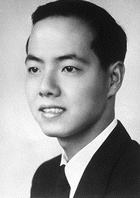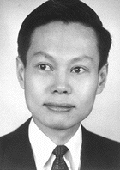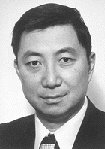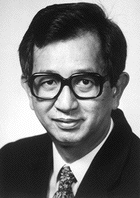|
GOLDSEA |
ASIAMS.NET |
ASIAN AMERICAN PERSONALITIES
THE MOST BRILLIANT ASIAN AMERICANS
OF ALL TIME
PAGE 1 OF 2
 rue brilliance connotes the shedding of bright light to help us see more of the universe and our place in it.
rue brilliance connotes the shedding of bright light to help us see more of the universe and our place in it.
That was our working definition in selecting the first dozen Asian Americans to kick off this category. A dozen is a poetic starting point. We expect many suggestions for expanding it to accommodate other less obvious but intensely luminous figures.
It may come as little surprise that the majority are drawn from the fields of science and technology. It's the intellectually broad-shouldered area to which Asian Americans have contributed most remarkably so far -- so much so that some may be tempted to dismiss these as routine or pedestrian.
That would be a shame. Each profiled scientist came by his light through long, uniquely lonesome and intensive effort, and each illuminates a uniquely exciting frontier of human thought.
The same can be said for the three whose fluorescence touches the human spirit in ways more easily related to everyday life. The architect, the literary critic, the jurist must all follow long, unique paths to attain the perspective and integrity required to generate renewing light.
This is a living list, to be adjusted as time reveals other brilliant Asian Americans or amplifies on the significance of those listed.
 1. Tsung-Dao Lee
1. Tsung-Dao Lee
Noted for the originality, versatility and elegance of his mind, theoretical physicist T D Lee became the second youngest scientist ever to win a Nobel Prize. Lee was barely 31 when he and onetime mentor C N Yang accepted the physics prize in 1957 for their work in showing that the theta-meson and tau-meson — elementary particles that exhibit opposite parity in decay mode — are in fact the same particle (now called the K-meson), leading to the conclusion that the principle of parity conservation is violated at least in weak interactions. More recently T D Lee has contributed to the understanding of violations of time-reversal invariance in certain weak interactions.
Lee was born November 24, 1926 in Shanghai, China. At the age of 29 he became the youngest member of Columbia University's faculty.
 2. Chen Ning Yang
2. Chen Ning Yang
C N Yang's longtime focus on statistical mechanics and symmetry principles came together to suggest the violation of parity conservation in weak reactions, the work that won him, together with T D Lee, the 1957 Physics Nobel Prize. He was a physics professor at the Princeton Institute for Advanced Study until 1966, then directed the Institute of Theoretical Physics at SUNY Stony Brook until 1999. Since 1993 he has divided his time between the U.S. and Hong Kong where he is director of mathematics at the Chinese University.
Yang was born September 22, 1922 in China's Anwhei Province. His father was a math professor. Yang is a hard worker of modest habits who has published a long list of scientific papers.
 3. Chien-Shiung Wu
3. Chien-Shiung Wu
Madam Wu is arguably the most admired female scientist in U.S. history and one of the most talented experimental physicists of all time. Her procedure for using gaseous diffusion to separate U235 from U238 was key to the Manhattan Project's success in building the world's first atomic bomb. In 1956 she devised an elegant experiment to prove out the Nobel-winning theory of CN Yang and T D Lee that parity is not conserved in weak nuclear reactions. She placed a salt of radioactive cobalt-60 in a strong magnetic field to line up the nuclei, supercooled it to minimize random thermal motion, then observed the distribution of emitted electrons. Most went in one direction, proving out the earlier computations of Yang and Lee. For that and other pioneering work, Madame Wu became a celebrity of the scientific community.
Wu was born May 29, 1912 in Shanghai, China. She received a PhD in physics from UC Berkeley in 1940 and taught at Smith and Princeton. She was a senior research scientist at Columbia when she began work on the Manhattan Project.
CONTINUED BELOW
 4. Steven Chu
4. Steven Chu
Steven Chu became the second U.S.-born Asian ever to win a Nobel by using six lasers to trap and cool sodium atoms down to 240 millionths of a degree above absolute zero. This procedure enabled a quantum leap in the study of the relationship between matter and energy and won him the 1997 Nobel Prize in Physics. Chu has been a professor of physics and applied physics at Stanford University since 1987.
Chu was born in St. Louis in 1948. His father taught chemical engineering at Washington University. Today Chu continues to refine and expand laser cooling and trapping techniques to tackle other problems of experimental physics.
 5. Samuel Chao Chung Ting
5. Samuel Chao Chung Ting
Samuel C C Ting became the first U.S.-born Asian ever to win a Nobel Prize by virtue of having been born prematurely on January 27, 1936 while his Chinese parents were visiting Ann Arbor, Michigan. Twenty years later Ting returned to the University of Michigan for degrees in math and physics. While pursuing experimental work in Germany, Ting became a leader in the technique of detecting elementary particles by studying electron-positron pairs produced by firing protons at high speeds. He brought his experimental team back to the U.S. to continue their work at the Brookhaven National Laboratory.
In the fall of 1974, using a 300-meter proton gun with a beryllium target area, Ting's team discovered a new heavy parent particle dubbed the J-particle. The trick was to detect these particles before they decay within hundredths of millions of a second into the electron-positron daughter pairs. For his work Ting shared the 1976 Physics Nobel Prize with a scientist who independently discovered the same particle using a particle accelerator 3-kilometers in diameter.
 6. Yuan T. Lee
6. Yuan T. Lee
Yuan T. Lee won the 1986 Nobel Prize in Chemistry, along with two others, for devising techniques for cross-directing molecular beams for more precise study of processes involved in a wide variety of chemical reactions, including those among relatively large molecules. Since 1974 Lee had been working as a UC Berkeley professor and a popular principal investigator at the Lawrence Berkeley Laboratory. Lee was born in November of 1936 in Hsinchu, Taiwan. More recently, Lee has devoted himself to studying reactions that are important in combustion and atmospheric chemistry.
PAGE 2
1-6 |
7-12
|
|
|
|

CONTACT US
|
ADVERTISING INFO
© 1996-2013 Asian Media Group Inc
No part of the contents of this site may be reproduced without prior written permission.
|
 4. Steven Chu
4. Steven Chu
 5. Samuel Chao Chung Ting
5. Samuel Chao Chung Ting
 6. Yuan T. Lee
6. Yuan T. Lee

 rue brilliance connotes the shedding of bright light to help us see more of the universe and our place in it.
rue brilliance connotes the shedding of bright light to help us see more of the universe and our place in it.
 1. Tsung-Dao Lee
1. Tsung-Dao Lee
 2. Chen Ning Yang
2. Chen Ning Yang
 3. Chien-Shiung Wu
3. Chien-Shiung Wu





